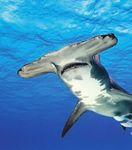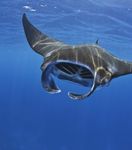Global Progress on Shark, Ray CITES Listings
←
→
Page content transcription
If your browser does not render page correctly, please read the page content below
A brief from Mar 2019
Global Progress on Shark,
Ray CITES Listings
Countries are taking action, but many species still need protection
Overview
Each year, at least 63 million and as many as 273 million sharks are killed in the world’s commercial fisheries,
an unsustainable fishing rate driven by increasing demand for their fins, meat, liver oil, and other products.1 As
a result, shark populations have suffered declines worldwide, and more than half of shark species and their
relatives assessed by the International Union for Conservation of Nature are categorized as Threatened or Near
Threatened with extinction.2
But a turning point for shark conservation came in 2013, when five commercially traded species—oceanic
whitetip; porbeagle; and great, scalloped, and smooth hammerhead sharks—and two species of manta ray
were added to Appendix II of the Convention on International Trade in Endangered Species of Wild Fauna and
Flora (CITES). This listing requires that any international trade in these species be legal and not detrimental to
populations in the wild. Three years later, CITES parties added bigeye, common, and pelagic thresher sharks;
silky sharks; and mobula rays to Appendix II, bringing to 20 the number of commercially important shark and
ray species subject to trade measures. While more work is needed to stabilize populations of these vulnerable
species worldwide, the CITES listings have prompted unprecedented implementation action by the parties.Porbeagle/Doug Perrine Mobula ray/Getty Images Oceanic whitetip/iStock
Measures to implement CITES listings
Dakar, Senegal
Stan Shea While CITES aims to ensure that international trade in species does not threaten the animals’ survival, the listings
have prompted governments, often for the first time, to properly manage their shark and ray fisheries or offer
these animals full protection within their waters. Development of NDFs, prohibiting catch or trade of CITES-listed
Workshops species, or establishing full protections can all be used to implement CITES listings for sharks and rays.
Since 2016, more than 70 governments have participated in regional and domestic workshops on how to ensure
Countries can continue international trade in a species listed on Appendix II if they conduct an NDF that shows
that trade in sharks and rays listed on Appendix II is legal and sustainable.
that the trade is legal and sustainable. Sri Lanka, New Zealand, and Indonesia, among others, have done that,
These workshops aim to promote cooperation between customs, environment, and fisheries officials and build making use of new, freely available electronic tools. Other countries—such as Cape Verde, the Philippines, and the
capacity domestically and among countries. Training topics included the role of governments in regulating United Arab Emirates—have prohibited the export or catch of all or some CITES-listed shark species. Still others,
international trade, identifying shark species based on their fins, providing enforcement guidance, and conducting such as India, have put in broader measures, such as prohibiting the export of shark fins. Some governments,
non-detriment findings (NDFs)—the determination required by CITES to allow countries to continue their trade including most recently Samoa and the Dominican Republic, have gone even further, prohibiting commercial
in listed species. Armed with these tools, countries can meet their CITES obligations and play an essential role in fishing, possession, sale, and trade of shark and ray species and their products in their waters.
reducing shark mortality globally.
Table 1
Figure 1 How Countries Are Implementing CITES Appendix II Listings
Global CITES Implementation: Shark and Ray Workshops Since 2013
NDFs* and/or fisheries controls Species-specific catch/trade prohibitions Shark/ray product trade bans
Australia Belize Mozambique Dominican Republic
Colombia Cape Verde Pakistan India (only fins)
Germany Costa Rica Colombia Peru Myanmar
Switzerland
Armenia Ecuador Dominican Republic Philippines Samoa
Morocco
Pakistan China Indonesia India Samoa United Arab Emirates (only fins)
Egypt United Arab Taiwan, Province of China Dominican Republic
Emirates Japan Indonesia Taiwan, Province of China
Mauritania India Hong Kong Guatemala
Bangladesh Philippines El Salvador Mexico Malaysia Thailand
Cape Oman
Yemen Panama
Verde Myanmar Maldives United Arab Emirates
Senegal Sri Lanka Colombia
Kenya
Ecuador
Brazil
New Zealand Mexico United States
Indonesia Peru
Samoa Peru
Australia Fiji
Sri Lanka
South Africa
Chile United States
Vietnam
*Positive, meaning countries are able to continue trade.
Note: These management steps are a result of shark and ray CITES Appendix II listings and were compiled using the best publicly available
Regional Domestic Regional and Domestic data. While all measures are only as effective as their enforcement, these Appendix II listings also prompted governments such as Hong Kong
and Colombia to take action to strengthen enforcement measures.
© 2019 The Pew Charitable Trusts © 2019 The Pew Charitable Trusts
2 3Figure 2
Countries That Have Implemented CITES
Appendix II Listings Since 2013
United States Japan
North America
of America Pacific
Ocean
Pakistan
Dominican Republic Taiwan, Province of China
India
India Thailand
Mexico
Belize Vietnam
United Arab Philippines
Costa Rica Myanmar
Emirates
Cape Verde Malaysia
Colombia Sri Lanka
Ecuador Indonesia
Pacific Maldives
Ocean Peru Indian
Ocean Samoa
Australia
Australia
Atlantic
Mozambique
Ocean
New Zealand
Note: The countries highlighted above were compiled using the best publicly available data.
© 2019 The Pew Charitable Trusts
4 5Implementing CITES in the global trade hub, Hong Kong
Over half of the annual global shark fin trade passes through Hong Kong, making it critical that its government
take an active role in curtailing illegal and unsustainable trade. Hong Kong’s Agriculture, Fisheries, and
Conservation Department has been at the forefront of global efforts to implement the new CITES listings. Since
2014, the Hong Kong government has hosted nine workshops to train its customs and enforcement officials on
how to visually identify fins of CITES-listed species. Using at least in part the skills they gained in these sessions,
Hong Kong customs personnel seized more than 5 metric tons of shark fins from 2014 through July 2018.
Enforcement tools
Through training, government officials from at least 70 countries have learned how to identify and stop illegal
trade in CITES-listed shark and ray species. A wide range of tools is available in multiple languages, including
shark fin identification guides and posters, to help governments ensure that continued trade in these species
is legal, sustainable, and traceable. Table 2 provides a summary of these tools, many of which can be found at
www.identifyingsharkfins.org or on the CITES shark portal.
Table 2 Stan Shea
Tools for Stopping Illegal Trade
A summary
A visual guide that wildlife inspectors and border personnel can use to rapidly identify the first dorsal fins
Shark fin ID guide and pectoral fins of the nine commercially exploited shark species in their most commonly traded form
(e.g., frozen or dried and unprocessed). https://www.identifyingsharkfins.org
A condensed form of the shark fin ID guide to help officials quickly identify commonly traded shark fins.
Shark fin ID posters
https://www.identifyingsharkfins.org
Genetic tools can be used on fins as well as meat and other traded products to further verify species
identification at various points of the supply chain, from harvest to consumption. The manual synthesizes
DNA manual all available DNA protocols in published literature, outlining which to use depending on how processed
the shark product is (dried, frozen, etc.). All shark and ray species listed on CITES can be identified using
these genetic protocols. https://www.identifyingsharkfins.org
Because CITES requires countries that wish to continue exporting Appendix II-listed species to conduct
an NDF, these NDF guides are electronically available and are intended to ensure that exporting a listed
Non-detriment finding species will not threaten its survival. In 2014, the German Federal Agency for Nature Conservation, the
(NDF) guides International Union for Conservation of Nature, and TRAFFIC produced detailed guidelines on developing
NDFs to advise governments seeking to export CITES-listed shark species. https://www.cites.org/eng/
prog/ndf/index.php
This assay can identify all shark species listed by CITES and most that are traded internationally. The
Multiplex PCR The Pew Charitable Trusts
findings are based on a single polymerase chain reaction (PCR) and one to two downstream DNA-
mini-barcode
sequencing reactions. https://citessharks.org
iSharkFin
Software that allows port inspectors, customs agents, fish traders, and other users without formal
taxonomic training to identify species by submitting a photo of a fin. http://www.fao.org/ipoa-sharks/
Conclusion
tools/software/isharkfin
CITES has become a driving force in global shark conservation and management. And countries have shown
A website with a variety of information from CITES and the Food and Agriculture Organization of the a commitment to implementing all of the CITES shark and ray Appendix II listings and to continuing the
United Nations to help countries implement shark and ray listings. This includes a shark ID materials
CITES shark portal
database, guidance on how to develop NDFs, details of relevant meetings past and future, and an archive momentum to properly manage these species worldwide. But even with the progress made since 2013, only 3.9
of national and regional reports, studies, posters, and multimedia. https://www.cites.org/prog/shark to 17.8 percent of the global fin trade is regulated.3 Clearly, more work is needed to ensure that these vulnerable
species receive the protections a CITES Appendix II listing can provide.
© 2019 The Pew Charitable Trusts
6 7Endnotes
1 Boris Worm et al., “Global Catches, Exploitation Rates, and Rebuilding Options for Sharks,” Marine Policy 40 (2013): 194-204, http://
www.sciencedirect.com/science/article/pii/S0308597X13000055.
2 Nicholas K. Dulvy et al., “Extinction Risk and Conservation of the World’s Sharks and Rays,” eLife 3 (2014): 1-34, http://dx.doi.
org/10.7554/eLife.00590.
3 Andrew T. Fields et al., “Species Composition of the International Shark Fin Trade Assessed Through a Retail-Market Survey in Hong
Kong,” Conservation Biology 32, no. 2 (2017): 376-89, https://doi.org/10.1111/cobi.13043. The seminal study on the global shark fin trade
indicates that 11.8 to 15.5 percent of the global shark fin trade is now listed on CITES Appendix II. For more on this study, see Shelley
C. Clarke et al., “Identification of Shark Species Composition and Proportion in the Hong Kong Shark Fin Market Based on Molecular
Genetics and Trade Records,” Conservation Biology 20, no. 1 (2006): 201-11, https://doi.org/10.1111/j.1523-1739.2005.00247.x.
For further information, please visit:
pewsharks.org
2
Cover photos:
1. Thresher shark/Jason Arnold 2. Silky shark/Jim Abernethy
1 3 4 3. Manta ray/Getty Images 4. Hammerhead shark/Getty Images
Contact: Barbara Cvrkel, communications officer
Email: bcvrkel@pewtrusts.org
Project website: pewsharks.org
The Pew Charitable Trusts is driven by the power of knowledge to solve today’s most challenging problems. Pew applies a rigorous, analytical
approach to improve public policy, inform the public, and invigorate civic life.You can also read
























































